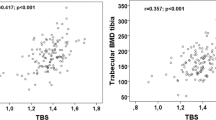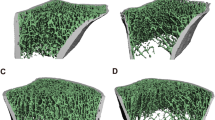Abstract
Summary
Bone microarchitecture by high-resolution peripheral quantitative computed tomography (HR-pQCT) was assessed in adult patients with mild, moderate, and severe osteogenesis imperfecta (OI). The trabecular bone score (TBS), bone mineral density (BMD) by dual-energy X-ray absorptiometry (DXA), and dual X-ray and laser (DXL) at the calcaneus were likewise assessed in patients with OI. Trabecular microstructure and BMD in particular were severely altered in patients with OI.
Introduction
OI is characterized by high fracture risk but not necessarily by low BMD. The main purpose of this study was to assess bone microarchitecture and BMD at different skeletal sites in different types of OI.
Methods
HR-pQCT was performed in 30 patients with OI (mild OI-I, n = 18 (41.8 [34.7, 55.7] years) and moderate to severe OI-III-IV, n = 12 (47.6 [35.3, 58.4] years)) and 30 healthy age-matched controls. TBS, BMD by DXA at the lumbar spine and hip, as well as BMD by DXL at the calcaneus were likewise assessed in patients with OI only.
Results
At the radius, significantly lower trabecular parameters including BV/TV (p = 0.01 and p < 0.0001, respectively) and trabecular number (p < 0.0001 and p < 0.0001, respectively) as well as an increased inhomogeneity of the trabecular network (p < 0.0001 and p < 0.0001, respectively) were observed in OI-I and OI-III-IV in comparison to the control group. Similar results for trabecular parameters were found at the tibia. Microstructural parameters were worse in OI-III-IV than in OI-I. No significant differences were found in cortical thickness and cortical porosity between the three subgroups at the radius. The cortical thickness of the tibia was thinner in OI-I (p < 0.001), but not OI-III-IV, when compared to controls.
Conclusions
Trabecular BMD and trabecular bone microstructure in particular are severely altered in patients with clinical OI-I and OI-III-IV. Low TBS and DXL and their significant associations to HR-pQCT parameters of trabecular bone support this conclusion.



Similar content being viewed by others
References
Forlino A, Cabral WA, Barnes AM, Marini JC (2011) New perspectives on osteogenesis imperfecta. Nat Rev Endocrinol 7:540–557. doi:10.1038/nrendo.2011.81
Ben Amor IM, Glorieux FH, Rauch F (2011) Genotype-phenotype correlations in autosomal dominant osteogenesis imperfecta. J Osteoporos 2011:540178. doi:10.4061/2011/540178
Marini JC, Reich A, Smith SM (2014) Osteogenesis imperfect due to mutations in non-collagenous genes: lessons in the biology of bone formation. Curr Opin Pediatr 26:500–507. doi:10.1097/MOP.0000000000000117
Marini JC, Cabral WA, Barnes AM, Chang W (2007) Components of the collagen prolyl 3-hydroxylation complex are crucial for normal bone development. Cell Cycle 6:1675–1681
Martinez-Glez V, Valencia M, Caparrós-Martin JA, Aglan M, Temtamy S, Tenorio J, Pulido V, Lindert U, Rohrbach M, Eyre D, Giunta C, Lapunzina P, Ruiz-Perez VL (2012) Identification of a mutation causing deficient BMP1/mTLD proteolytic activity in autosomal recessive osteogenesis imperfecta. Hum Mutat 33:343–350. doi:10.1002/humu.21647
Sillence DO, Senn A, Danks DM (1979) Genetic heterogeneity in osteogenesis imperfecta. J Med Genet 16:101–116
Friedman AW (2006) Important determinants of bone strength: beyond bone mineral density. J Clin Rheumatol 12:70–77. doi:10.1097/01.rhu.0000208612.33819.8c
Wekre LL, Eriksen EF, Falch JA (2011) Bone mass, bone markers and prevalence of fractures in adults with osteogenesis imperfecta. Arch Osteoporos 6:31–38. doi:10.1007/s11657-011-0054-z
Lindahl K, Barnes AM, Fratzl-Zelman N, Whyte MP, Hefferan TE, Makareeva E et al (2011) COL1 C-propeptide cleavage site mutations cause high bone mass osteogenesis imperfecta. Hum Mutat 32:598–609. doi:10.1002/humu.21475
Roschger P, Fratzl-Zelman N, Misof BM, Glorieux FH, Klaushofer K, Rauch F (2008) Evidence that abnormal high bone mineralization in growing children with osteogenesis imperfecta is not associated with specific collagen mutations. Calcif Tissue Int 82:263–270. doi:10.1007/s00223-008-9113-x
Land C, Rauch F, Munns CF, Sahebjam S, Glorieux FH (2006) Vertebral morphometry in children and adolescents with osteogenesis imperfecta: effect of intravenous pamidronate treatment. Bone 39:901–906. doi:10.1016/j.bone.2006.04.004
Boutroy S, Bouxsein ML, Munoz F, Delmas PD (2005) In vivo assessment of Trabecular bone microarchitecture by high-resolution peripheral quantitative computed tomography. J Clin Endocrinol Metab 90:6508–6515. doi:10.1210/jc.2005-1258
Amin S, Khosla S (2012) Sex- and age-related differences in bone microarchitecture in men relative to women assessed by high-resolution peripheral quantitative computed tomography. J Osteoporos 2012:129760. doi:10.1155/2012/129760
Liu XS, Zhang XH, Sekhon KK, Adams MF, McMahon DJ, Bilezikian JP, Shane E, Guo XE (2010) High-resolution peripheral quantitative computed tomography can assess microstructural and mechanical properties of human distal tibial bone. J Bone Miner Res 25:746–756. doi:10.1359/jbmr.090822
Hans D, Barthe N, Boutroy S, Pothuaud L, Winzenrieth R, Krieg MA (2011) Correlations between trabecular bone score, measured using anteroposterior dual-energy X-ray absorptiometry acquisition, and 3-dimensional parameters of bone microarchitecture: an experimental study on human cadaver vertebrae. J Clin Densitom 14:302–312. doi:10.1016/j.jocd.2011.05.005
Pothuaud L, Barthe N, Krieg MA, Mehsen N, Carceller P, Hans D (2009) Evaluation of the potential use of trabecular bone score to complement bone mineral density in the diagnosis of osteoporosis: a preliminary spine BMD-matched, case-control study. J Clin Densitom 12:170–176. doi:10.1016/j.jocd.2008.11.006
Hakulinen MA, Saarakkala S, Toyras J, Kroger H, Jurvelin JS (2003) Dual energy X-ray laser measurement of calcaneal bone mineral density. Phys Med Biol 48:1741–1752
Thorpe JA, Steel SA (2006) The DXL Calscan heel densitometer: evaluation and diagnostic thresholds. Br J Radiol 79:336–341. doi:10.1259/bjr/22191429
Brismar TB, Janszky I, Toft LI (2010) Calcaneal BMD obtained by dual X-ray and laser predicts future hip fractures—a prospective study on 4 398 Swedish women. J Osteoporos 2010:875647. doi:10.4061/2010/875647
Muschitz C, Dimai HP, Kocijan R, Kaider A, Zendeli A, Kuhne F et al (2013) The discriminatory capacity of BMD measurements by DXA and dual X-ray and laser (DXL) at the calcaneus including clinical risk factors for detecting patients with vertebral fractures. Osteoporos Int. doi:10.1007/s00198-013-2266-0
Van Dijk FS, Sillence DO (2014) Osteogenesis imperfecta: clinical diagnosis, nomenclature and severity assessment. Am J Med Genet A 164A:1470–1481. doi:10.1002/ajmg.a.36545
Burghardt AJ, Pialat JB, Kazakia GJ et al (2013) Multicenter precision of cortical and trabecular bone quality measures assessed by high resolution peripheral quantitative computed tomography. J Bone Miner Res 28:524–536. doi:10.1002/jbmr.1795
Hind K, Oldroyd B, Truscott JG (2010) In vivo precision of the GE Lunar iDXA densitometer for the measurement of total-body, lumbar spine, and femoral bone mineral density in adults. J Clin Densitom 13:413–417. doi:10.1016/j.jocd.2010.06.002
Silva BC, Leslie WD, Resch H, Lamy O, Lesnyak O, Binkley N, McCloskey EV, Kanis JA, Bilezikian JP (2014) Trabecular bone score: a noninvasive analytical method based upon the DXA image. J Bone Miner Res 29:518–530. doi:10.1002/jbmr.2176
Bart ZR, Hammond MA, Wallace JM (2014) Multi-scale analysis of bone chemistry, morphology and mechanics in the oim model of osteogenesis imperfecta. Connect Tissue Res 55(Suppl 1):4–8. doi:10.3109/03008207.2014.923860
Homan EP, Lietman C, Grafe I et al (2014) Differential effects of collagen prolyl 3-hydroxylation on skeletal tissues. PLoS Genet 10:e1004121. doi:10.1371/journal.pgen.1004121
Rauch F, Travers R, Parfitt AM, Glorieux FH (2000) Static and dynamic bone histomorphometry in children with osteogenesis imperfecta. Bone 26:581–589
Folkestad L, Hald JD, Hansen S, Gram J, Langdahl B, Abrahamsen B, Brixen K (2012) Bone geometry, density, and microarchitecture in the distal radius and tibia in adults with osteogenesis imperfecta type I assessed by high-resolution pQCT. J Bone Miner Res 27:1405–1412. doi:10.1002/jbmr.1592
Szulc P, Boutroy S, Vilayphiou N, Chaitou A, Delmas PD, Chapurlat R (2011) Cross-sectional analysis of the association between fragility fractures and bone microarchitecture in older men: the STRAMBO study. J Bone Miner Res 26:1358–1367. doi:10.1002/jbmr.319
Sornay-Rendu E, Boutroy S, Munoz F, Delmas PD (2007) Alterations of cortical and trabecular architecture are associated with fractures in postmenopausal women, partially independent of decreased BMD measured by DXA: the OFELY study. J Bone Miner Res 22:425–433. doi:10.1359/jbmr.061206
Zebaze RM, Ghasem-Zadeh A, Bohte A, Iuliano-Burns S, Mirams M, Price RI, Mackie EJ, Seeman E (2010) Intracortical remodelling and porosity in the distal radius and post-mortem femurs of women: a cross-sectional study. Lancet 375:1729–1736. doi:10.1016/S0140-6736(10)60320-0
Vardakastani V, Saletti D, Skalli W, Marry P, Allain JM, Adam C (2014) Increased intra-cortical porosity reduces bone stiffness and strength in pediatric patients with osteogenesis imperfecta. Bone 69:61–67. doi:10.1016/j.bone.2014.09.003
Leslie WD, Aubry-Rozier B, Lix LM, Morin SN, Majumdar SR, Hans D (2014) Spine bone texture assessed by trabecular bone score (TBS) predicts osteoporotic fractures in men: the Manitoba Bone Density Program. Bone 67:10–14. doi:10.1016/j.bone.2014.06.034
Boutroy S, Hans D, Sornay-Rendu E, Vilayphiou N, Winzenrieth R, Chalurpat R (2012) Trabecular bone score improves fracture risk prediction in non-osteoporotic women: the OFELY study. Osteoporos Int 24:77–85. doi:10.1007/s00198-012-2188-2
Leib E, Winzenrieth R, Lamy O, Hans D (2014) Comparing bone microarchitecture by trabecular bone score (TBS) in Caucasian American women with and without osteoporotic fractures. Calcif Tissue Int 95:201–208. doi:10.1007/s00223-014-9882-3
Silva BC, Walker MD, Abraham A, Boutroy S, Zhang C, McMahon DJ, Liu G, Hans D, Bilezikian JP (2013) Trabecular bone score is associated with volumetric bone density and microarchitecture as assessed by central QCT and HRpQCT in Chinese-American and White women. J Clin Densitom 16:554–561. doi:10.1016/j.jocd.2013.07.001
Gatti D, Colapietro F, Fracassi E, Sartori E, Antoniazzi F, Braga V, Rossini M, Adami S (2003) The volumetric bone mineral density and cortical thickness in adult patients affected by osteogenesis imperfecta. J Clin Densitom 6:173–177
Kocijan R, Muschitz C, Fratzl-Zelman N, Haschka J, Dimai HP, Trubrich A et al (2013) Femoral geometric parameters and BMD measurements by DXA in adult patients with different types of osteogenesis imperfecta. Skelet Radiol 42:187–194. doi:10.1007/s00256-012-1512-4
Kanis JA (2002) Diagnosis of osteoporosis and assessment of fracture risk. Lancet 359:1929–1936. doi:10.1016/S0140-6736(02)08761-5
Acknowledgments
The authors thank our study nurse Dragana Simic and our secretary Monika Binder-Ziegler for the coordination of the participants. We also thank Dr. Janina Patsch at the University Vienna, Department of Radiology, for her input regarding images and Tommy Vacca for proofreading.
Conflicts of interest
TBS iNsight Software is a product of Med-Imaps. Didier Hans is co-owner of the TBS patent and has corresponding ownership shares. Roland Kocijan, Christian Muschitz, Judith Haschka, Arastoo Nia, Angelika Geroldinger, Michael Ardelt, Robert Wakolbinger, and Heinrich Resch state that they have no conflicts of interest.
Author information
Authors and Affiliations
Corresponding author
Rights and permissions
About this article
Cite this article
Kocijan, R., Muschitz, C., Haschka, J. et al. Bone structure assessed by HR-pQCT, TBS and DXL in adult patients with different types of osteogenesis imperfecta. Osteoporos Int 26, 2431–2440 (2015). https://doi.org/10.1007/s00198-015-3156-4
Received:
Accepted:
Published:
Issue Date:
DOI: https://doi.org/10.1007/s00198-015-3156-4




